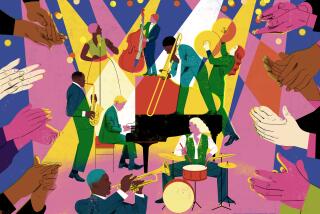Failing Health Couldn’t Keep Jazzman From Favorite Festival
- Share via
In the final period of Lionel Hampton’s long life, after a series of strokes that left his performance ability and speech impaired, he maintained a fierce desire to stay in the swim of the musical life.
He kept active in the last five years of his life by touring and playing the role of a wise elder in jazz, and an important part of that annual regimen took him to Moscow, Idaho, every February to preside at the Lionel Hampton Jazz Festival.
In the wintry landscape of a small university town in western Idaho, Hampton was king. He had visited for a week each year since 1987, when the music school at the University of Idaho was named after Hampton, and he took over steering an on-campus festival whose roots date back 30 years. A $60-million Lionel Hampton Jazz Center, to include his archives, is in the building process, slated for a 2006 opening.
The de facto head and organizing force of the festival is the university’s Lynn J. Skinner, but Hampton was very much the smiling epicenter. Photographs of his early visage loomed over the stage, and a life-size bronze of the man and his vibes stood, sentry-like, in one corner. In the four, long evening concerts in the university’s Kibbie Dome, Hampton would perch in an overstuffed chair by the stage, egging on the parade of musicians, both the famous as well as budding winners of the festival’s large student competition (up to 15,000 students descend for the festival). Occasionally, Hampton would sit in on a tune with top-drawer house bands, such as 1997’s ensemble band that included Hank and Elvin Jones, saving his own official performance for last.
Hampton’s name was enough to bring to Moscow a stellar cast of jazz players, which in recent years has included Ray Brown, Joe Lovano, Diana Krall, Conte Candoli, Roy Hargrove, Abby Lincoln (who memorably sang Hampton’s classic ballad “Midnight Sun” to him onstage a few years ago), and countless others.
The Moscow trips also included a day trip to the town of Lapwe, on the Nez Perce Reservation. In a touching musical exchange from a few years back, Hampton and a roster of visiting musicians performed for schoolchildren, with a display of Native American dance in return. On the way back to Moscow, the festival entourage would stop at the Nez Perce Casino for lunch and some slot-machine action, and Hampton would have a close encounter with lady luck.
At this year’s festival--Hampton’s final public performance--infirmity reportedly kept Hamp’s playing from the nimbleness of his pre-stroke years, and sometimes he had to get lyric cues from his drummer when singing his signature “What a Wonderful World.” But age and declining health would not keep Hampton from the festival.
Two years ago, in an interview at his New York apartment, Hampton visibly warmed when I mentioned his annual Moscow retreat. He seemed most excited about the educational prospect of the Moscow operation: “We have a great group of music teachers there, to vocalize and synthesize things, to get as much training in jazz as possible. They help to keep the jazz going. This is the only art form that is truly American.
“I think that we should teach our kids good ideas and [emphasize] advancement. I think that we should adhere to a pulse, if it’s a good pulse, and see that we take care of things the folks care about.”
More to Read
The biggest entertainment stories
Get our big stories about Hollywood, film, television, music, arts, culture and more right in your inbox as soon as they publish.
You may occasionally receive promotional content from the Los Angeles Times.







